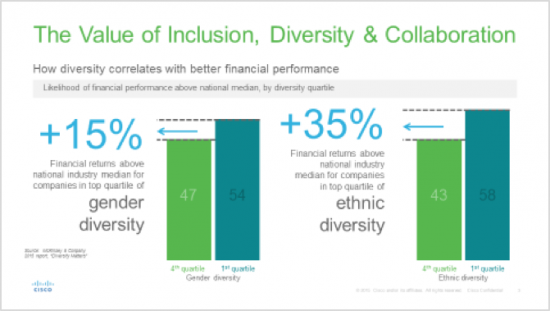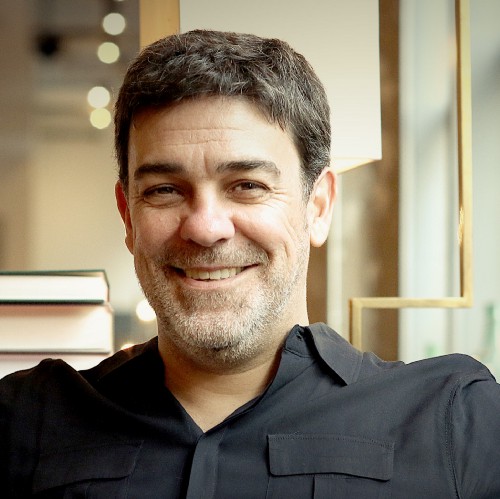Diversity is a hot topic. Unfortunately, it usually makes the headlines for the wrong reasons, like what happened at Starbucks, United Airlines, or Yale University.
Organizations tend to operate as if we are an open and welcoming society, but we are not. They’ve made a lot of progress increasing diversity awareness and becoming more inclusive. However, talent is equally distributed, but opportunities are still not.
The opportunity lies in moving from demographic diversity to a culture that embraces diverse thinking.
Diversity is good for business
Most organizations actively promote diversity, according to a survey by Deloitte. However, the study shows that most fail to realize the business benefits of a diverse workforce.
How can companies benefit from building a truly diverse force? Not just by hiring ‘diverse’ people but by embracing new leadership styles, ways of thinking, perspectives and ideas.
Voya Financial made a strong commitment five years ago when it went public. The financial and insurance company realized it made business sense to have a diverse workforce to serve its heterogeneous clientele.
There’s a direct correlation between diversity and financial performance:
- Companies with gender diversity have 15% higher financial performance
- Ethnic diversity creates a more effective impact: 35% better financial performance
For Molson Coors, diversity is a strategic asset to find relevance across markets. What others achieve by scale and size, the brewing company wants to accomplish by being relevant. Cobra, a beer that is manufactured both in India and England, is a perfect example of connecting with people of Indian descent. Cobra has a share of over 98% of all licensed Indian restaurants within the UK.
As Luis Cardenas, VP Global Talent & Diversity, Molson Coors told me: “Diversity is good for business. Beer brings people together, the better we understand and connect with a diverse audience, the better we can bring people together.”
For Ericsson, diversity, and inclusion plays a prominent role in its employee brand. The Swedish multinational networking and telecommunications company sees the changing job environment as an opportunity. Technology is creating new jobs; filling roles that didn’t exist previously opens more possibilities.
Attracting and developing women of color to the tech industry is challenging. Computer science has declined as a career among that segment, and hiring managers are victims of unconscious biases.
Ericsson has invested heavily in content to attract more women — engaging in events such as the “Girls who innovate” competition as well as celebrating all women and minority-driven events. Most importantly, it has partnered with bloggers and innovators — real women share their stories, not the corporation.
As Lisa Smith-Strother, Sr. Director Global Head of Employee brand, explained: “It gives Ericsson the degree of credibility. It comes from the platform, not from us. Real women serve as our brand voice.”
Deloitte has recognized Ericsson as an example to follow. Currently, 40% of the traffic to its recruitment website comes from women. And 29% of total new hires in 2017 were women.

The challenge of quotas
Metrics are essential to track performance, but should not drive decision-making. The pressure to meet diversity goals can overshadow talent.
Inclusion is good — it’s about being more open-minded. Equality can be misleading though. We are not all equal. That’s the magic part of being human — everyone brings their uniqueness to the workplace. Equal pay is a perfect example. Why can’t women make more than men in a particular job? Equality can create an artificial ceiling.
Organizations need to be smart — to find the right opportunity rather than to force diversity across all positions.
In the beer industry, there are very few women that are truck drivers. Should companies persuade them to do so or find opportunities that align with their interests?
Most beer salespeople are men. When hiring new talent, industry experience is a must. Thus, beer sales positions are biased towards men. How do you break that pattern?
As Mr. Cardenas explained: “We hire über talented people and train them to become beer experts. Organizations must challenge their assumptions and usual behaviors.”
Technology and financial services suffer from similar patterns. They are unwelcoming industries and suffer from limited talent pipeline. The lack of diverse resources can lower the bar. Everyone is poaching high-qualified diverse talent from each other.
Enterprise software development Atlassian is fighting those barriers by teaching women and people over 40 how to code. Voya Financial hires African American or Latinos with robust capabilities and potential and then develops their industry-specific expertise.
The diversity journey is not a smooth ride
Organizational culture can be nurtured and developed, but cannot be forced or imposed. The need to meet Diversity goals doesn’t come free of tensions.
Those who belong to the so-called ‘majority’ are complaining that people from under-represented segments are getting more opportunities. Even though social activists believe that reverse racism is not for real, some people feel left out when society is trying to level the field for minorities.
On the other hand, advocates get tired of fighting an uphill battle. Promoting the benefits of diversity takes time, and the results are not as fast as many people would like.
As Aubrey Blanche, Global Head of Diversity at Atlassian explained: “Since 2013, there hasn’t been a significant paradigm shift. Advocates are suffering from Diversity Fatigue — people get tired of listening to the benefits of diversity, but not seeing the results or a significant change.”
Ericsson has consistently been investing in programs to drive awareness on the issues and how people can actively contribute. Now, 50% of attendees to women-focused panels or workshops are men. The organization has learned the importance of integrating people rather than creating more islands. Inclusivity works both ways — Ericsson celebrates men’s day too.
Design a diverse culture
Diversity is an outcome, though most companies approach it as an input. They focus on representation, rather than on mindset.
The push for quotas has created a lot of confusion — some organizations seem to be playing a ‘check-off the list’ game.
Successful organizations must hire for cultural fitness, not just cultural fit as I explained here. Diversity of thinking drives innovation.
At Fortay.ai, a predictive culture analytics platform, there are no quotas. Nonetheless, 40% of its engineers are women — a remarkable record for the tech industry. The organization focuses on values and beliefs when recruiting people. By hiring the right talent, diversity has become a natural outcome.
“What you want to avoid are personality (or psychometric) assessments, which can focus too much on the ‘who side of the equation’ and can be homogenizing.” — explains Marlina Kinnersley, CEO, and Co-founder of Fortay. “Instead you want to focus on the values and beliefs alignment in the context of a workplace culture that is inclusive.”
Building a culture of diversity requires more than good intentions or motivational speeches.
Culture is the ‘behavior you reward and punish’ as Jocelyn Goldfein wrote.
“For us, a culture of diversity is an accelerator of team performance and financial performance.” — explains Kevin Silva, EVP Chief Human Resources at Voya Financial. “The way we rate managers says a lot about our commitment: 50% of the score are hard goals, the other 50% is based on their achievements prioritizing diversity, living and leading the culture, as well as developing other people.”
Molson Coors has a question on its internal engagement survey that measures “how inclusive mid-managers are.” It helps track improvements but is also a reminder of the company’s commitment.
Fortay’s data analysis demonstrates that diverse companies have employees that are more effective, more connected to the organization’s mission, feel they can behave more authentically and genuinely belong — they stay longer too.
Diversity requires a long-term vision
Any cultural transformation requires time and consistency. Creating a diverse culture from scratch is much easier than changing one that has been traditionally homogenous and closed. Atlassian encourages a “no-BS culture” — transparency is critical so that people can express, respectfully, their points of views.
Unconscious bias training plus awareness events are not enough — diversity requires a long-term and in-depth approach.
As Kevin Silva said: “Diversity is like planting a garden. You need to prepare the soil, but also you must nurture and maintain diversity. It’s a constant journey.”
It took Voya five years to build a diversity culture that got wide industry recognition — it required full commitment from senior leaders. Not only the CEO believes in diversity; the Board Members and the C-Suite have heterogenous composition both from a gender and race perspective.
Similarly, Molson Coors prides itself on having a very global executive team with folks from South Africa, Panama, U.S., and England.
The beer manufacturer approaches diversity as a long-term investment — though business pressure to deliver short-term results can get in the way. Day-to-day needs also challenge Ericsson: hiring managers want to get someone in the door and fill the open positions ASAP.
Shifting From Diversity to Acceptance
To drive a cultural transformation requires, not just to emphasize the benefits but, also the ‘why.’ Being more open and acceptant of those who are different to us is the key. However, empathy is a hard ability to develop.
Even though most organizations show a real commitment to diversity, they are still using the term “diverse groups” to refer to minorities.
That’s a great paradox. True diversity is not about a group, but the sum of all. Calling some people ‘diverse’ implies positioning the ‘majority’ as normal. Thus, making “diverse groups” out of the norm.
The most critical shift is to help teams embrace diversity of thinking while avoiding an ‘us’ versus ‘them’ divide. We are all unique and different. Integrating those perspectives is what makes the team richer.
As human beings, we are wired to establish hierarchies. Rather than taking people for who they are; we judge them by the group they belong to.
Let’s address the real issues — tackle the root cause, not just the symptoms. And be ready to have open and uncomfortable conversations.
As Aubrey Blanche said: “We haven’t prepared people on how to act on it. We need to provide more tactics and strategies that are actionable. How do you create a sense of belonging for everyone?”
1. Build a Culture of Acceptance:
“Diversity goes beyond sex, age, and gender. For us, people with special needs are part of our overall strategy.” — Kevin Silva
We all have layers, commonalities, and differences. Accepting those who think differently requires understanding that is better to be human than to be always right.
Acceptance goes well beyond understanding unconscious biases. It requires deep self-awareness. Change happens from within, it cannot be imposed. Modifying people’s beliefs is very hard — rather than trying to change their minds, focus on the behaviors.
Culture is a byproduct of social interactions — everyone uniqueness shapes the culture and is formed by it too.
2. Focus on Cultural Fitness
“It’s about the bigger picture, not just ethnicity or gender. Promote diversity of thoughts.” — Lisa Smith-Strother
Diversity needs to move from demographics to thinking. Problem-solving requires broad perspectives — greater innovation doesn’t feed on group thinking.
Encourage your team to dissent. Many organizations silence the tensions — avoiding conflicts doesn’t get rid of them; it just makes things worse. If you value diversity of opinions, be ready for passionate discussions.
3. Provide a safe space for candid conversations
“In highly effective teams, personality and smarts don’t matter; Psychological safety does.” — Bohdan Zabawskyj, Co-founder, Fortay
Create a space for open conversations. Let people express their concerns— alignment is an illusion.
Building Psychological Safety is critical to removing the fear of being judged. To address tensions, they need to surface first.
Let people ask questions — as long as they do it respectfully, don’t censor candid feedback. Everyone learns by listening to those who ask questions that most have in mind
Atlassian practices the “No interruption rule.” Minorities feel intimidated or uncomfortable sharing — they are normally interrupted. This practice allows everyone to chime in.
4. Integrate rather than create a bigger divide
“Avoid creating the ‘them’ versus ‘us’ approach.” — Aubrey Blanche
There’s a risk that many people could feel left behind when ‘minorities’ are the new privileged.
Diversity is about the sum of all parts, not about one part in particular. Avoid making it about one segment: it could backfire. Focus on cultural balance instead.
5. Don’t let metrics overshadow empathy
“Quotas shouldn’t drive decisions. Metrics help track progress, but they must not become a detriment to performance or hiring the best people.” —Luis Cardenas
There’s a perception that pushing too hard for diversity can hurt the organization. Avoid hiring for representation — corporate recruiters are now biased to embrace diversity as this article explains.
Setting goals is important, but the ‘why’ matters the most. What type of culture do you want to promote?
People don’t just need to feel welcomed; they need to be part of the bigger whole. They need to feed the organizational culture as well as feed off the culture too. Belonging goes beyond tolerance and acceptance — people should feel free to bring their true self to the ‘party.’
We are just peeling the onion when it comes to diversity. Let’s leverage both business and human benefits: financial performance and compassion, respectively.
Diversity is the byproduct of a culture — it requires embracing diversity of perspectives.
Challenge the notion of normality. The sum of everyone’s perspectives makes a company more powerful. As Ken Blanchard said: “None of us is as smart as all of us.”
Before you leave
Download my ebook “Stretch Your Team: how to thrive in a changing world: get your free copy.
Receive my weekly “Insights for Changemakers”: Sign Up Now


